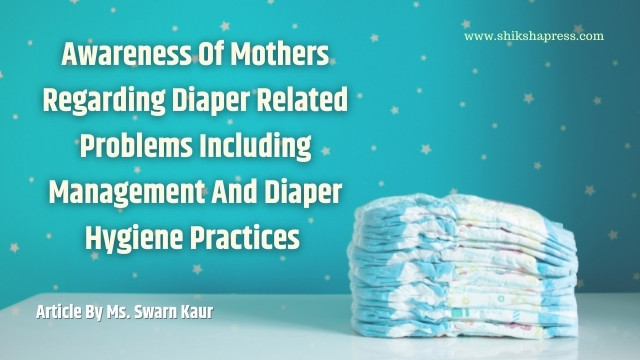Awareness Of Mothers Regarding Diaper Related Problems Including Management And Diaper Hygiene Practices (Article)
INTRODUCTION: Diaper problem is one of the most common skin infections in infants and toddlers. It is commonly caused by irritation in the diaper area. The rash is usually evident on the abdomen, genitalia, and inside the skin folds of the thighs and buttocks and affects infants between the ages of 4 and 15 months. Diaper problem is one of the most common skin infections in infants and toddlers. It is commonly caused by irritation in the diaper area.
The rash is usually evident on the abdomen, genitalia, and inside the skin folds of the thighs and buttocks and affects infants between the ages of 4 and 15 months. The severity can be mild to extreme, in some cases containing open sores or a secondary infection. Diaper Dermatitis has been wrongfully labeled as a sign of poor parenting skills and child neglect.
This misunderstanding around Diaper Rash has led to ill-advised mothers combing through lists of purported remedies with little success. Treatment failure is common because the effective management of Diaper Rash requires the recognition and control of predisposing factors. The use of medical remedies has little chance of success without concomitant control of predisposing factors.
A study concluded that the prevalence of diaper dermatitis was 36.1%, a rate which significantly decreased with age. The highest prevalence was found in subjects who were one to six months old. Risk factors were diaper changing fewer than three times/night, previous episodes of diaper rash, using cloth diapers, and topical application of baby talcum powder to the diaper area. The presence of diaper dermatitis has been found to be associated with discomfort, irritation, and pain, which affects neonates’ quality of life.

A cross-sectional study to measure the prevalence of diaper dermatitis and identify the risk factors among Chinese children aged 1-24 months by a structured questionnaire face-to-face interview. Revealed 15 risk factors were identified out of that major cause for diaper dermatitis is due to changing > 6 diapers/day with the occurrence rate of 43.8% diaper dermatitis.7 Around 40% and 75% of diaper rashes that are seen for more than 3 days are colonized with Candida albicans. Candida has a fecal origin and is not an organism normally found on perineal skin. Amoxicillin was found to increase the colonization by Candida and worsens the diaper dermatitis.8
Approximately one-quarter (21% to 27.5%) of parenting women report diaper needs in which they lack adequate diapers care to keep their child sufficiently diapered for hygiene and comfort. The high frequency of diaper dermatitis in very young children, and the fact almost half of infants and toddlers in the United States live in low-income families10.
AIM OF THE STUDY: The study is intended to assess the awareness regarding the diaper-related problems including management and diaper hygiene practice of diaper-wearing children (0 to 2 years) in selected areas of Faridkot, Punjab, India.
MATERIAL AND METHODS: Quantitative research approach with a descriptive research design was used. 200 mothers of diaper-wearing children (0 to 2 years) were selected for this descriptive study and were recruited through a Convenient sampling technique for this study. Tools used for this study were a socio-demographic sheet, a self-structured awareness questionnaire, and a self-reporting checklist for hygiene practices.
RESULTS: Results revealed that among 200 mothers, 148 mothers of diaper-wearing children had moderately adequate awareness, followed by 33 mothers of diaper-wearing children who had inadequate awareness whereas 19 mothers of diaper-wearing children had adequate awareness. In hygiene practices, 163 mothers of diaper-wearing children had good hygiene practices, followed by 36 mothers of diaper-wearing children who had average hygiene practices, whereas 01 mother of the diaper-wearing child had poor hygiene practices.
CONCLUSION; Study concluded that approximately more than half of mothers of diaper-wearing children had moderately adequate awareness but in hygiene practices approximately more than half of the mothers had good hygiene practices. Statistically, a significant association was found between age of the mother with awareness regarding diaper related problems including management p=0.041 and in hygiene practices, there was a significant association between the type of family with hygiene practices i.e p=0.019
KEYWORDS: Awareness, diaper-related problems, management, hygiene practices, mothers of diaper-wearing children.
This article contains the personal views of the author: Article By Ms. Swarn Kaur, Dean, Students Welfare College of Nursing (AIMS), Sri Muktsar Sahib (Punjab)








1 thought on “Awareness Of Mothers Regarding Diaper Related Problems Including Management And Diaper Hygiene Practices”